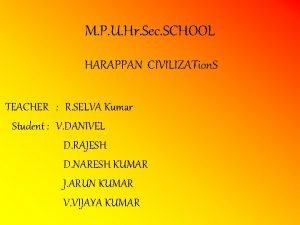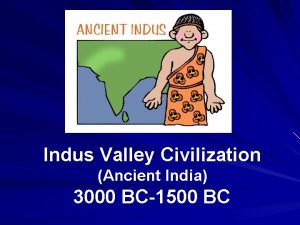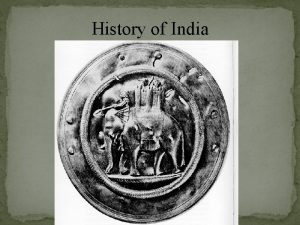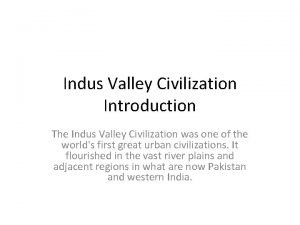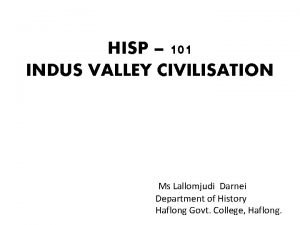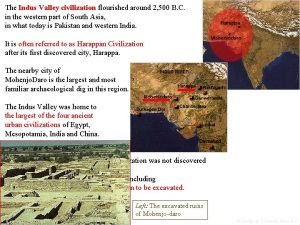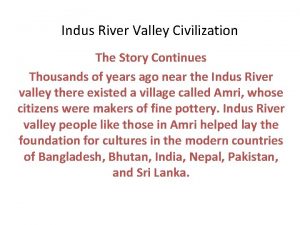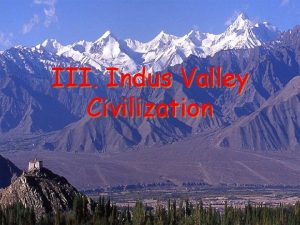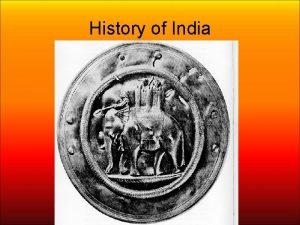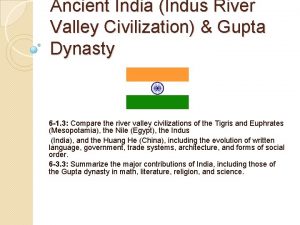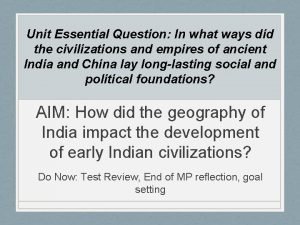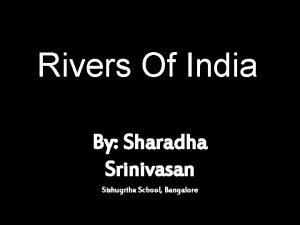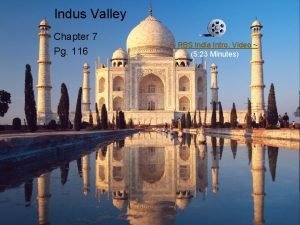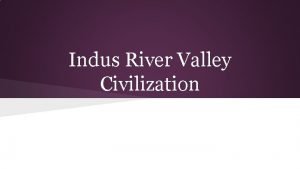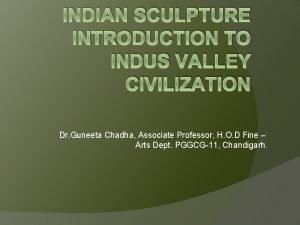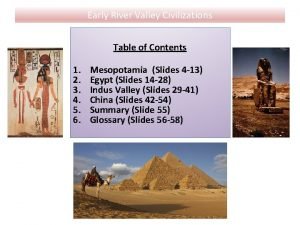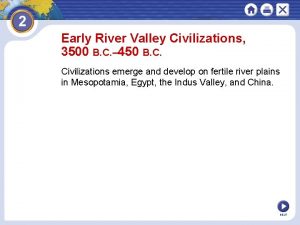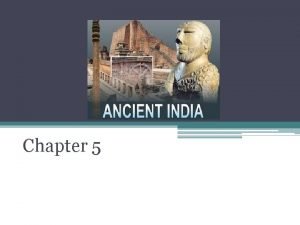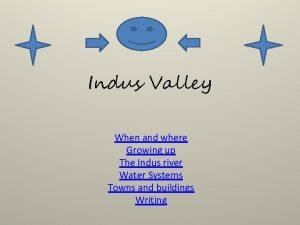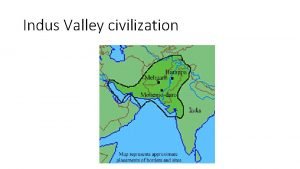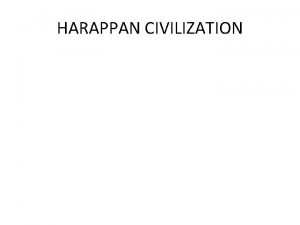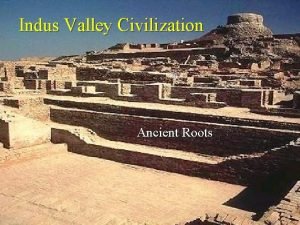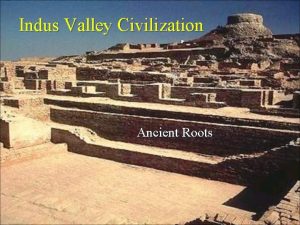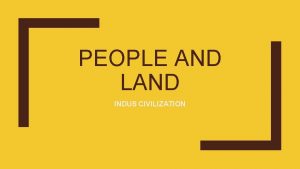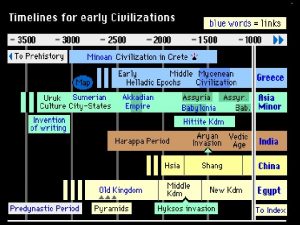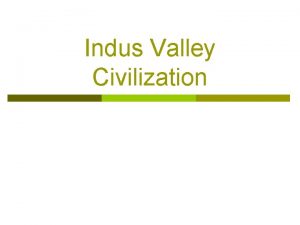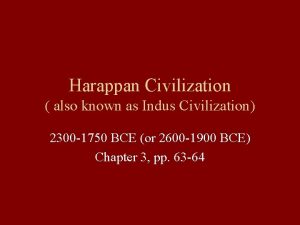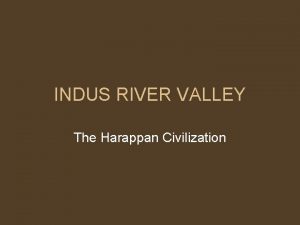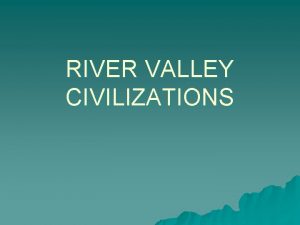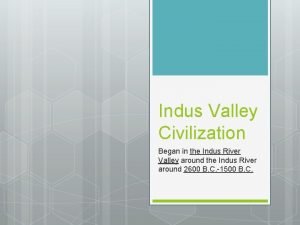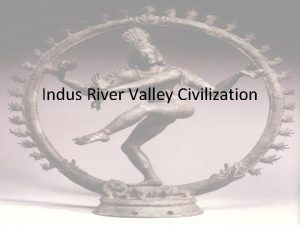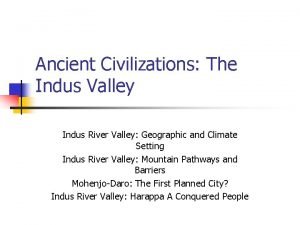Indus Valley Civilization Harappan Society Chapter 4 Notes
























- Slides: 24

Indus Valley Civilization (Harappan Society) Chapter 4 Notes

Roots of Indus Valley Civilization • Earliest civilization in Indus River Valley was discovered in 1856 by a railroad crew. • Modern-day Pakistan – Harappa – Mohenjo-daro or “Hill of the Dead”

• Page: 92

Roots of Indus Valley Civilization • Settlers in Indus Valley as early as 7000 B. C. E. – Possibly began as herders who moved into the river valley during colder months. – Began trading by boat along the Indus, into the Arabian Sea and the Persian Gulf, into Mesopotamia. – Indus River prone to course changes…what happens to cities when this occurs? – All knowledge comes from artifacts – no insight from writing, as in Mesopotamia and Egypt

Carefully Planned Cities • Began about 2500 B. C. E. - survived for around 500 years. • Both Harappa and Mohenjo-Daro, two of the largest among 500 sites, were three miles in circumference with around 40, 000 people. • Streets laid in GRID PATTERN

Mohenjo-Daro and Harappa • To the north is a CITADEL or raised/fortified area. • On the summit was a huge communal BATH. • Next to the large bath was a huge open space—a GRANARY where food was stored from possible floods. • Fortified walls mark the southeast corner.


Harappa and Mohenjo-daro • Private houses – private WELL, BATH, and TOILET (consisting of a brick seat over a drainage area). • Brick-lined drains flushed by water, carried liquid and solid waste to sumps, where it was carted away, probably to fertilize nearby fields. EARLY SEWERS. • Houses raised to protect from floods • What do these tell us about the people? ? ?

Harappa and Mohenjo-daro • Town plan was regular – evidence of central authority • Fire-baked bricks were uniform in size and shape. • No monumental architecture found to clearly mark the presence of a palace or temple. • There is little sign of social stratification in the plan or buildings.

Enter: The Aryans • Roughly 1500 B. C. E. – nomadic pastoral group of Indo-Europeans passed through the Hindu Kush mountains. (Khyber Pass) • Called themselves “ARYANS” or “noble people. ” • Established small herding and agricultural communities throughout northern India.

Aryan Influence on Harappan Society • Aryan migrations took place over several centuries. • Their arrival was not an invasion or organized military campaign. • It is likely that Indo-European migrants clashed with Dravidians (people settled in the Harappan area. ) • By the time Aryans entered India, internal problems and river shifting had already brought Harappan society to the point of collapse. • During the centuries after 1500 B. C. E. , Dravidian and Indo-European peoples intermarried and laid social and cultural foundations that influenced Indian society to present day.

Aryan Influence on Harappan Society • The Aryans survived on pastoral economy, sheep and goats. • Especially prized their horses and cattle • Aryans consumed both dairy products and beef. Much later cattle would become sacred.

Aryan Influence on Harappan Religion • Vedas - collections of religious and literary poems and songs transmitted orally. Eventually written in Sanskrit. • Four Vedas…. Most important was the Rig Veda, a collection of 1, 028 hymns addressed to the Aryan gods. • Aryan priests compiled the Rig Veda between 1400 and 900 B. C. E. • It wasnt put into writing until about 600 B. C. E.

The Vedic Age 1500 to 500 B. C. E. • Aryans often had friendly relations with Dravidian peoples. • Learned about the land adopted Dravidian agricultural methods. • Still there was competition over land resources. • It appears that the Aryans did not have a formal government but they formed chiefdoms with a leader known as a raja (Sanskrit term for king. )

Aryan Migrations Within India • Aryans first settled in the Punjab, the upper Indus River valley that straddles modern-day border between northern India and Pakistan. • They spread east and south and established communities throughout much of the subcontinent. • They learned to make iron tools, and with axes and plows, they cleared forests and established agricultural communities in the Ganges valley. • The Aryans gradually lost the tribal political organization they had brought into India and evolved into small kingdoms with formal governments.

The Caste System • Originally based on color: Aryans were “wheat-colored” and Dravidians were darker skinned. • Four Main Varnas or Castes: § Priests (Brahmins) § Warriors (Kshatriyas) § Artisans and merchants (Vyaisyas) § Landless peasants and serfs (Sudras) § Untouchables (people who performed dirty tasks) were added much later

Jati (Subcastes) • As Vedic Society became more complex and specialized, the caste system changed to include specialized occupations. • REINCARNATION – rebirth of the soul in a new form • Occupation determined an individual’s jati (subcaste). • By the 18 th and 19 th centuries C. E. , the system featured several thousand jati. • Brahmins alone have over 1, 800 jati.

Gender Roles • Aryan Society had a strong patriarchal social order at the time of their migration into India. • All priests, warriors and tribal chiefs were men. • Women influenced affairs within their families but had no public authority. • Women rarely learned the Vedas and were denied formal education. • Sati - practice of a wife sacrificing herself on her husband’s funeral pyre (fire), was considered noble.

Religion in Vedic Age • Rig Veda sheds light on religious practices. • Many, many gods • Indra - war god • Brahma – the Creator • Vishnu – the Preserver • Shiva – the Destroyer • Cattle, sheep, goats, and horses from Aryan herds were sacrificed to gain divine support, large families, long life, and abundant herds.

Religion in Vedic Age • Around 800 B. C. E. some individuals withdrew into the forest of the Ganges valley and lived as hermits. • Drew inspiration from religious beliefs of Dravidian people who worshipped nature spirits. • Dravidians also believed that human souls took on new physical forms after the deaths of their bodies. • Idea of reincarnation became dominant. • Religion became more mystical – early Hinduism

The Upanishads • Appeared late in Vedic Age - 800 to 400 B. C. E. • Upanishad means “sitting in front of” and refers to practice of disciples gathering before a sage for discussion of religious issues. • The Upanishads were dialogues that explored the Vedas.

The Upanishads • Each person is part of a large, cosmic order and forms a small part of a universal soul known as Brahman. • Brahman is an eternal, unchanging foundation for all things. • Individual souls born into physical world many times. • Souls are most often humans, but sometimes animals, and even occasionally plants. • The highest goal of the individual soul is to escape the cycle of birth and rebirth to enter into permanent union with Brahmin. (state of peace and liberation - Moksha)

Important Teaching of the Upanishads • Samsara – Upon death, individuals go temporarily to the World of the Fathers and then return to earth in a new form. • Karma – “…a man of good acts will become good, a man of bad acts, bad. He becomes pure by pure deeds, bad by bad deeds. ” • Suffering – A certain amount of pain and suffering is inevitable in human existence. • Moksha - deep endless sleep that comes with permanent liberation from physical incarnation. • Honesty, self-control, charity, mercy, respect for all living things…leads to vegetarianism, still important in Hinduism today.

Effect of Religion During the Vedic Age • Modern historians have often interpreted the Upanishads as a way to justify social inequalities imposed by the Caste System. • The doctrines of Samsara and karma have reinforced the Vedic social order. Quick question…how can religion be used to subjugate people?
 Egyptian goddess of medicine
Egyptian goddess of medicine Mpu hr
Mpu hr Aryan civilization
Aryan civilization Economy of the harappan civilization
Economy of the harappan civilization Indus valley civilization trade and economy
Indus valley civilization trade and economy Indus era
Indus era Conclusion on harappan civilization
Conclusion on harappan civilization Natural resources of indus valley civilization
Natural resources of indus valley civilization The indus valley civilization flourished around
The indus valley civilization flourished around Indus river
Indus river Indus valley game
Indus valley game Economy of indus valley civilization
Economy of indus valley civilization Language b
Language b Mature harappan sites on political map
Mature harappan sites on political map Conclusion of harappan civilization
Conclusion of harappan civilization Indus valley civilization period
Indus valley civilization period Conclusion on harappan civilization
Conclusion on harappan civilization Introduction about harappan civilization
Introduction about harappan civilization Introduction about indus valley civilization
Introduction about indus valley civilization Mesopotamia technology
Mesopotamia technology Drainage system in harappan civilization
Drainage system in harappan civilization Mauryan empire mind map
Mauryan empire mind map Growing up in the indus valley
Growing up in the indus valley Growing up in the indus valley
Growing up in the indus valley Indus river valley hinduism
Indus river valley hinduism

